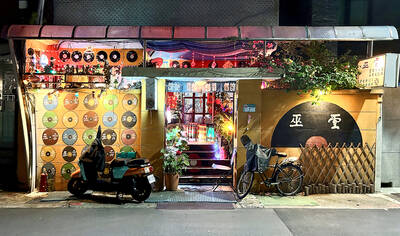Solo Pasta should appeal to health conscious 20 to 40-somethings who work and shop in Taipei’s East District (東區). The Italian eatery, which opened six months ago in an alley behind Eslite Bookstore’s Dunnan Branch (台北敦南誠品) limits its entree menu to an array of pastas that are notable for their originality and fresh ingredients.
The menu may be small, but the restaurant’s interior is rather large, with two dining sections; the first as you move past the large windows at the entrance, the second facing the open kitchen. Mustard-yellow tongue-and-grove paneling on the walls and wood laminate on the tables and floors lends the space a comfortable atmosphere.
Aside from pasta, the restaurant has a moderately sized appetizer menu that is somewhat hit and miss. The bruschetta (NT$60) falls into the latter category because its presentation seemed an afterthought. Chunks of fresh tomato infused with olive oil and basil were scattered over the surface of the first slice, while the second supported a swath of delicious chicken liver mousse. Though the mousse had a creamy texture and robust flavor with hints of balsamic vinegar, the portion was too small. There are no other bread items on the menu, which seems a little puzzling for an Italian restaurant that limits its main course menu selection to pasta.
The oven-baked eggplant with mozzarella and Parmesan (NT$160) was a hit, as were the assorted marinated mushrooms (NT$80). In the former, three layers of eggplant alternated with a thick tomato sauce and were topped with a moderate amount of cheese. This light dish was delicious and ideal for those watching their waste size, though it might have benefitted from a pinch of basil or oregano. The mushrooms marinated in spices, white while vinegar and olive oil perked things up with their tangy flavor and crunchy texture.
Other appetizer items that I was told are worth trying include asparagus with runny egg and extra-old Parmesan (NT$280) and raw vegetables with garlic and anchovy dip (NT$230 for two).
My waitress said that the squid ink spaghettini (NT$280), sweet basil pesto spaghettini (NT$220) and smoked duck in a cream balsamic sauce with spaghetti (NT$260) are among patrons’ favorites. I went with the duck because friends who work near Solo Pasta have raved about it before. The slightly sweet balsamic vinegar cream sauce acted as a nice counterpoint to the strong smokiness of the duck. The sauce is delicious and alone makes a trip to Solo Pasta worthwhile. Now all they need to do is add plain bread to the menu so customers can slop up the yummy sauce when the pasta is gone.
The dessert menu is also worth a try. The generous slab of tiramisu consisted of a mascarpone body infused with marsala (a dessert wine similar to sherry), which rested on an espresso-dipped foundation of ladyfingers (NT$80). Other desserts include oranges marinated in caramelized syrup and served with frozen chocolate (NT$150) and cannolo, or pastry tubes filled with ricotta cheese (NT$160).

The Lee (李) family migrated to Taiwan in trickles many decades ago. Born in Myanmar, they are ethnically Chinese and their first language is Yunnanese, from China’s Yunnan Province. Today, they run a cozy little restaurant in Taipei’s student stomping ground, near National Taiwan University (NTU), serving up a daily pre-selected menu that pays homage to their blended Yunnan-Burmese heritage, where lemongrass and curry leaves sit beside century egg and pickled woodear mushrooms. Wu Yun (巫雲) is more akin to a family home that has set up tables and chairs and welcomed strangers to cozy up and share a meal

Dec. 8 to Dec. 14 Chang-Lee Te-ho (張李德和) had her father’s words etched into stone as her personal motto: “Even as a woman, you should master at least one art.” She went on to excel in seven — classical poetry, lyrical poetry, calligraphy, painting, music, chess and embroidery — and was also a respected educator, charity organizer and provincial assemblywoman. Among her many monikers was “Poetry Mother” (詩媽). While her father Lee Chao-yuan’s (李昭元) phrasing reflected the social norms of the 1890s, it was relatively progressive for the time. He personally taught Chang-Lee the Chinese classics until she entered public

Last week writer Wei Lingling (魏玲靈) unloaded a remarkably conventional pro-China column in the Wall Street Journal (“From Bush’s Rebuke to Trump’s Whisper: Navigating a Geopolitical Flashpoint,” Dec 2, 2025). Wei alleged that in a phone call, US President Donald Trump advised Japanese Prime Minister Sanae Takaichi not to provoke the People’s Republic of China (PRC) over Taiwan. Wei’s claim was categorically denied by Japanese government sources. Trump’s call to Takaichi, Wei said, was just like the moment in 2003 when former US president George Bush stood next to former Chinese premier Wen Jia-bao (溫家寶) and criticized former president Chen

President William Lai (賴清德) has proposed a NT$1.25 trillion (US$40 billion) special eight-year budget that intends to bolster Taiwan’s national defense, with a “T-Dome” plan to create “an unassailable Taiwan, safeguarded by innovation and technology” as its centerpiece. This is an interesting test for the Chinese Nationalist Party (KMT), and how they handle it will likely provide some answers as to where the party currently stands. Naturally, the Lai administration and his Democratic Progressive Party (DPP) are for it, as are the Americans. The Chinese Communist Party (CCP) is not. The interests and agendas of those three are clear, but